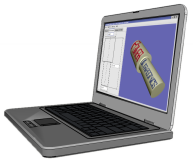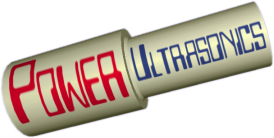A new online ultrasonics components store has just opened at www.UltrasonicsWorld.com. Check their amazing prices for replacement ultrasonics components, fully compatible with the major manufacturers' originals at a fraction of the cost.
You are here
June 2000
Dear subscriber;
Welcome to the June PowerUltrasonics newsletter. I'm aiming to put out newsletters every six weeks or so when there have been developments on the site to report. Please feel free to forward a copy to anyone else you think would be interested.
Not much news this time - I've been busy with a new site at www.cheers.au.com Nothing about ultrasonics there - it's offering web maps of Australia as a service to other web-sites - but please take a look if you have the time. It needs testing and I'd welcome any comments you can give me... Meanwhile, a question: Could magnetostrictive transducers be making a come-back??
~~~~~~~ GIANT MAGNETOSTRICTIVE MATERIALS ~~~~~~~~~~~~~~~
I'd like to start with a little history lesson if I may (experts can skip the next few paragraphs - I dont want to teach granny to suck eggs!)
Back in the 60's and 70's, when many applications of power ultrasonics were being developed, transducer technology was based on the magnetostrictive principle. Laminated cores of nickel alloy were wound with PTFE-insulated wire (why PTFE? Because the things would get hot enough to melt conventional plastic insulation!). A large alternating current in the coil, often combined with a large dc biasing current, generated a magnetic field in the core which responded by changing shape - the magnetostrictive effect - producing mechanical vibrations.
Then in the late 70's the piezo-electric sandwich transducer was introduced, and this has come to dominate the industrial power transducer market, at least in the west. This transducer uses ceramic disks sandwiched between two metal blocks, with a high-tensile screw through the centre holding it all together. The piezo-electric ceramics respond to an electric field, rather than a magnetic one, so coils are not required - instead an alternating voltage is supplied to electrodes between the disks.
The magnetostrictive transducers were extremely robust and relatively easy to manufacture, maintain and repair. Also their low Q allowed them to operate over a wide frequency range, so accurate tuning was not generally required. The one major drawback was their lack of efficiency - they would soak up a lot of power for little effect - and this was exacerbated by the use of power supplies operating at constant power. (While the transducer was running under no load, the power supply would still be pumping in 1 or 2 kW - all of which would be dissipated as heat).
By contrast piezo-electric transducers offered very high efficiency (conversion of electrical power into mechanical), and could run at higher amplitude, provided they were built well. This is not as easy as it sounds - all the interfaces must be VERY smooth and flat to ensure a constant pressure on the ceramics, otherwise they will break. Also this technology demands much more from the power supplies - driving a piezo transducer at constant power is not recommended! As soon as the mechanical load is removed the vibration amplitude will rise high enough to break either the ceramic disks or the clamping screw. Instead power supplies adjust themselves automatically to provide just enough power to maintain the transducer at its design amplitude. Furthermore the high Q means that the transducer only operates in a very narrow frequency band (as little as 1 or 2 Hz) and this changes as the system warms up, so generators must also track resonant frequency automatically.
So piezo-electric transducers came to dominate, offering higher amplitude and output power, their shortcomings largely overcome by careful manufacture and improved power supplies. But could that now be about to change?
New giant magnetostrictive materials (GMMs)
In the past few weeks I've been contacted independently by two suppliers of GMM's, who are again (still?) producing magnetostrictive ultrasonic power transducers: Etrema in the USA and Gansu in China.
The new materials are alloys of iron and rare earth metals - more efficient than the traditional materials, but how the transducers compare to piezos remains to be seen. What really caught my interest was the very high power capacity of the Etrema systems - they are producing a 6kW transducer already with something much larger on the way (whereas piezo transducers tend to be limited to around 3-4 kW max, and with their narrow frequency band it's not easy to use more than one). This could open up new large-scale applications of ultrasonics... Any suggestions?
Links to information on both magnetostrictive and piezo-electric systems are on the articles page.
These companies, naturally, have also been added to the supplier database, bringing the total to 114 suppliers in 16 countries. I have also added a new product category: Giant magnetostrictives (When I set up the system I set an arbitrary limit of 25 characters for each product category. As you can see, I'm not keen to change it...)
If you would like to add this to the database entry for your organisation, or modify it in any other way, go to the database page (link above), find your details and click on "Modify".
~~~~~~~~~~~~~~~~~~ VISITOR STATS ~~~~~~~~~~~~~~~~~~~
The number of visitors to PowerUltrasonics continues to grow. April was a bit flat - just a slight increase over March - but May brought a bumper 50% increase in visitors. Who would have thought there was a market for such an esoteric subject? Where are you all coming from?!!
As it happens, I do know at least which countries you are coming from...
Here's the combined list for April and May:
Argentina, Australia, Belarus, Belgium, Brazil, Bulgaria, Canada, Chile, Colombia, Denmark, Finland, France, Germany, Greece, Hong Kong, Hungary, India, Ireland, Israel, Italy, Japan, Lithuania, Malaysia, Malta, Mexico, New Zealand (Aotearoa), Netherlands, Norway, Poland, Portugal, Russian Federation, Saudi Arabia, Singapore, Slovak Republic, Slovenia, South Africa, South Korea, Sweden, Switzerland, Thailand, Turkey, Ukraine, United Kingdom, US Commercial, US Educational, US Government, US Military, Venezuela, Yugoslavia.
~~~~~~~~~~~~~~~~~~~~~~~~~~~~~~~~~~~~~~~~~~~~~~~~~~~~~~~~~~~~~~
That's all for this time. Feedback is always welcome...
Chris Cheers (chris@powerultrasonics.com)

